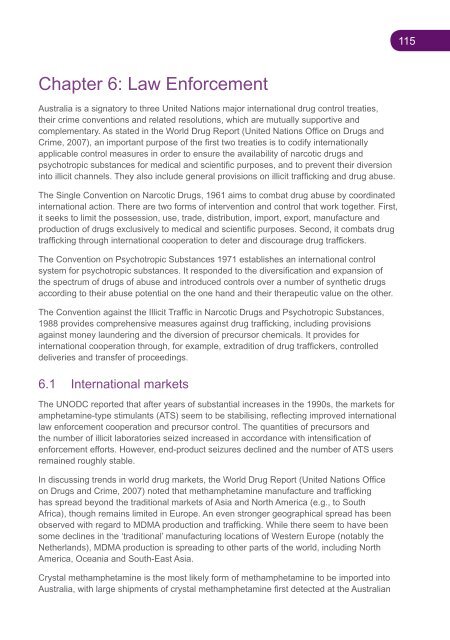National Amphetamine-Type Stimulant Strategy Background Paper
National Amphetamine-Type Stimulant Strategy Background Paper
National Amphetamine-Type Stimulant Strategy Background Paper
You also want an ePaper? Increase the reach of your titles
YUMPU automatically turns print PDFs into web optimized ePapers that Google loves.
115<br />
Chapter 6: Law Enforcement<br />
Australia is a signatory to three United Nations major international drug control treaties,<br />
their crime conventions and related resolutions, which are mutually supportive and<br />
complementary. As stated in the World Drug Report (United Nations Office on Drugs and<br />
Crime, 2007), an important purpose of the first two treaties is to codify internationally<br />
applicable control measures in order to ensure the availability of narcotic drugs and<br />
psychotropic substances for medical and scientific purposes, and to prevent their diversion<br />
into illicit channels. They also include general provisions on illicit trafficking and drug abuse.<br />
The Single Convention on Narcotic Drugs, 1961 aims to combat drug abuse by coordinated<br />
international action. There are two forms of intervention and control that work together. First,<br />
it seeks to limit the possession, use, trade, distribution, import, export, manufacture and<br />
production of drugs exclusively to medical and scientific purposes. Second, it combats drug<br />
trafficking through international cooperation to deter and discourage drug traffickers.<br />
The Convention on Psychotropic Substances 1971 establishes an international control<br />
system for psychotropic substances. It responded to the diversification and expansion of<br />
the spectrum of drugs of abuse and introduced controls over a number of synthetic drugs<br />
according to their abuse potential on the one hand and their therapeutic value on the other.<br />
The Convention against the Illicit Traffic in Narcotic Drugs and Psychotropic Substances,<br />
1988 provides comprehensive measures against drug trafficking, including provisions<br />
against money laundering and the diversion of precursor chemicals. It provides for<br />
international cooperation through, for example, extradition of drug traffickers, controlled<br />
deliveries and transfer of proceedings.<br />
6.1 International markets<br />
The UNODC reported that after years of substantial increases in the 1990s, the markets for<br />
amphetamine-type stimulants (ATS) seem to be stabilising, reflecting improved international<br />
law enforcement cooperation and precursor control. The quantities of precursors and<br />
the number of illicit laboratories seized increased in accordance with intensification of<br />
enforcement efforts. However, end-product seizures declined and the number of ATS users<br />
remained roughly stable.<br />
In discussing trends in world drug markets, the World Drug Report (United Nations Office<br />
on Drugs and Crime, 2007) noted that methamphetamine manufacture and trafficking<br />
has spread beyond the traditional markets of Asia and North America (e.g., to South<br />
Africa), though remains limited in Europe. An even stronger geographical spread has been<br />
observed with regard to MDMA production and trafficking. While there seem to have been<br />
some declines in the ‘traditional’ manufacturing locations of Western Europe (notably the<br />
Netherlands), MDMA production is spreading to other parts of the world, including North<br />
America, Oceania and South-East Asia.<br />
Crystal methamphetamine is the most likely form of methamphetamine to be imported into<br />
Australia, with large shipments of crystal methamphetamine first detected at the Australian

















